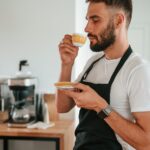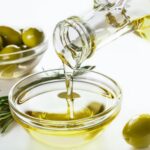Table of Contents
Picture this: it’s Sunday morning, and you’re sipping your steaming cup of coffee while nibbling on a scrumptious coffee-infused pastry. The rich aroma of freshly brewed java mingles with the sweet scent of baked goods, creating a symphony of sensory delight. Sounds like a dream, right? Well, hold onto your oven mitts, my fellow bakers, because today we’re going to explore the magical world of using coffee as a key ingredient in your baking.
I. Introduction
From the velvety layers of tiramisu to the indulgent mocha frosting on a decadent chocolate cake, coffee-flavored desserts have long held a special place in our hearts (and stomachs). But did you know that adding a splash of java to your favorite baked goods can elevate their flavor to stratospheric heights? In this comprehensive guide, we’ll walk you through the ins and outs of incorporating coffee into your baking repertoire, showcasing its versatility and the endless possibilities it offers.
II. Choosing the Right Coffee for Baking

Before we dive into the nitty-gritty of coffee-infused baking, let’s talk about the star of the show: the beans themselves. Just like in your daily cup of joe, the quality and type of coffee you use in your baking can make a world of difference in the final result. So, let’s explore some factors to consider when choosing your beans.
A. Importance of using high-quality coffee beans
Just as a great wine can elevate a dish, so too can exceptional coffee beans transform your desserts. Opt for high-quality, freshly roasted beans from a reputable source, and you’ll be rewarded with a depth of flavor that simply can’t be replicated by mass-produced, stale coffee. Remember, you’re not just brewing a cup; you’re infusing an entire dessert with the essence of these beans. Treat them with the respect they deserve, and they’ll return the favor in spades.
B. Differences between light, medium, and dark roasts
The roast level of your coffee beans will significantly impact the flavor profile of your dessert. Light roasts boast bright, fruity, and acidic notes, while medium roasts offer a balance of acidity, body, and sweetness. Dark roasts, on the other hand, are bold, smoky, and full-bodied. Consider the other flavors in your dessert when choosing a roast level. For instance, a fruity dessert may benefit from the bright notes of a light roast, while a rich chocolate cake might be best complemented by a robust dark roast.
C. Whole bean vs. pre-ground coffee for baking
While it may be tempting to reach for that bag of pre-ground coffee sitting in your pantry, grinding your own beans just before using them in your recipe will yield a fresher, more vibrant flavor. Pre-ground coffee can become stale and lose its nuance over time, so invest in a good-quality grinder and unlock the full potential of your beans.
D. Decaf options for those sensitive to caffeine
If you or your loved ones are sensitive to caffeine or simply prefer to avoid it, don’t worry! Decaf coffee can also be used in your baking endeavors. Just make sure to choose a high-quality decaf option to ensure the best possible flavor.
III. Different Forms of Coffee to Use in Baking
Now that we’ve covered the basics of selecting coffee beans, let’s delve into the various forms of coffee that can be used in baking. Each form has its unique qualities and applications, so let’s get acquainted with the options.

A. Brewed coffee
Brewed coffee is perhaps the most straightforward way to incorporate coffee flavor into your baking. Simply replace some or all of the liquid in your recipe with brewed coffee to give your dessert a delightful coffee kick. Keep in mind that brewed coffee will have a more subtle flavor than other forms of coffee, so it’s best suited for recipes that call for a gentle infusion of java.
B. Instant coffee or espresso powder
Instant coffee and espresso powder are both concentrated forms of coffee that can be easily added to batters, doughs, and frostings. They pack a more potent punch than brewed coffee, making them ideal for recipes that require a bold coffee flavor. When using instant coffee or espresso powder, remember to dissolve it in a small amount of hot water before adding it to your recipe to ensure even distribution.
C. Coffee extracts or flavorings
Coffee extracts and flavorings are another convenient option for adding coffee flavor to your baked goods. These concentrated liquids can be easily mixed into your recipes without affecting the consistency of your batter or dough. However, be cautious with the amount you use, as coffee extracts and flavorings can be quite potent.
D. Ground coffee beans
For a more rustic, textured coffee experience, consider incorporating finely ground coffee beans directly into your baking. This technique works particularly well in recipes like coffee-rubbed brownies or crunchy biscotti. Just be aware that using ground coffee beans will result in a grittier texture than other forms of coffee, so choose your recipes accordingly.
IV. Techniques for Incorporating Coffee into Baking Recipes
With our newfound knowledge of coffee forms in hand, let’s move on to the exciting part: incorporating coffee into your baking! From infusions to toppings, there’s no shortage of ways to make coffee the star of your dessert show.
A. How to create a coffee-infused simple syrup
A coffee-infused simple syrup is a versatile addition to your baking arsenal. To make it, combine equal parts sugar and brewed coffee in a saucepan and heat until the sugar has dissolved. This syrup can be drizzled over cakes or pastries, used as a soak for sponge cakes, or even mixed into buttercream frostings for an extra layer of coffee flavor.
B. Mixing coffee into batters and doughs
Whether you’re using brewed coffee, instant coffee, or espresso powder, incorporating coffee into your batters and doughs is a surefire way to infuse your baked goods with a rich coffee flavor. As mentioned earlier, remember to dissolve instant coffee or espresso powder in a small amount of hot water before adding it to your recipe. When using brewed coffee, simply replace part or all of the liquid called for in your recipe with your chosen java.
C. Adding coffee to frostings, fillings, and glazes
Frostings, fillings, and glazes are the perfect vehicles for showcasing the bold flavor of coffee. Instant coffee or espresso powder, as well as coffee extracts and flavorings, work particularly well in these applications. Experiment with adding coffee to buttercream, whipped cream, ganache, or even fondant to create a delectable coffee-infused accent for your desserts.
D. Using coffee as a topping or garnish
Don’t underestimate the power of a well-placed garnish or topping to elevate your coffee-infused desserts! Sprinkle finely ground coffee beans or espresso powder over your finished creations for a burst of flavor and visual appeal. You can also use chocolate-covered coffee beans or coffee-flavored candies as eye-catching decorations.

V. Pairing Coffee Flavors with Other Ingredients
One of the joys of baking with coffee is discovering the myriad flavor combinations that can be achieved by pairing coffee with other ingredients. From classic duos to unexpected delights, let’s explore some of the best coffee flavor pairings to inspire your baking adventures.

A. Classic coffee flavor combinations
- Coffee and chocolate: Arguably one of the most beloved pairings, coffee and chocolate are a match made in dessert heaven. The bitterness of coffee perfectly complements the sweetness of chocolate, creating a rich and indulgent flavor experience.
- Coffee and nuts: The earthy, buttery notes of nuts like walnuts, pecans, and hazelnuts pair beautifully with the bold flavors of coffee. Try adding a coffee-infused filling to a nutty tart or folding chopped nuts into a coffee-spiked brownie batter.
- Coffee and caramel: The sweet, sticky goodness of caramel is a natural partner for coffee’s robust bitterness. Drizzle a coffee-infused caramel sauce over a slice of cheesecake or incorporate coffee into a caramel buttercream frosting for a mouthwatering treat.
B. Unique and creative pairings
- Coffee and fruit: While it may not be the most obvious pairing, coffee can play surprisingly well with certain fruits. Berries like raspberries, cherries, and blackberries offer a tart counterpoint to coffee’s bitterness, while citrus fruits like oranges and lemons can bring a refreshing zing to coffee-infused desserts.
- Coffee and spices: Spices like cinnamon, nutmeg, and cardamom have a natural affinity for coffee, adding warmth and depth to your baked goods. Experiment with adding a pinch of your favorite spice to your coffee-infused recipes for an extra layer of complexity.
- Coffee and liqueurs: Coffee and liqueurs are a match made in boozy dessert heaven. Coffee liqueurs like Kahlúa or Tia Maria can enhance the coffee flavor in your desserts, while other liqueurs like amaretto, Irish cream, or orange liqueur can introduce interesting new flavor combinations.
VI. Tips for Storing and Serving Coffee-Flavored Desserts
Now that you’ve crafted your coffee-infused masterpiece, it’s essential to store and serve it properly to ensure the best possible flavor and presentation. Here are a few tips to keep in mind:
A. Proper storage techniques to maintain freshness and flavor
Most coffee-flavored desserts should be stored in an airtight container at room temperature or in the refrigerator, depending on the specific recipe. Be sure to consult your recipe’s instructions for optimal storage conditions, and always wrap your desserts well to prevent them from absorbing other flavors in your fridge or pantry.
B. How to serve coffee-infused desserts for maximum impact
Presentation is key when it comes to serving your coffee-infused creations. Consider using decorative plates, platters, or cake stands to showcase your desserts, and don’t forget to garnish with a sprinkle of espresso powder, chocolate-covered coffee beans, or a dusting of cocoa powder for an extra touch of elegance.
C. Pairing coffee-flavored treats with beverages
What better way to enjoy a coffee-infused dessert than with a perfectly paired beverage? A steaming cup of coffee or espresso is a natural choice, but you might also consider other options like a glass of dessert wine, a cold brew coffee, or even a coffee-inspired cocktail.
VII. Conclusion
Armed with the knowledge and inspiration from this guide, you’re ready to embark on your journey into the world of coffee-infused baking. So go forth, my fellow bakers, and let your creativity run wild as you explore the endless possibilities that coffee has to offer in the realm of desserts. Whether you’re crafting a classic tiramisu, experimenting with bold flavor pairings, or simply adding a touch of java to your favorite cookie recipe, one thing is for certain: you’ll never look at your morning cup of coffee the same way again.
Remember to have fun and let your passion for baking shine through as you create your coffee-infused masterpieces. After all, the true magic of baking lies not only in the delicious treats we create but also in the joy and love we share with others through our culinary creations. Happy baking!
Check out these coffee brownies!
Daily Demitasse is a participant in the Amazon Services LLC Associates Program, an affiliate advertising program designed to provide a means for sites to earn advertising fees by advertising and linking to Amazon.com. We also participate in other affiliate programs which compensate us for referring traffic.














